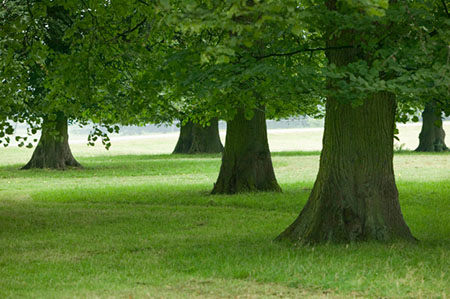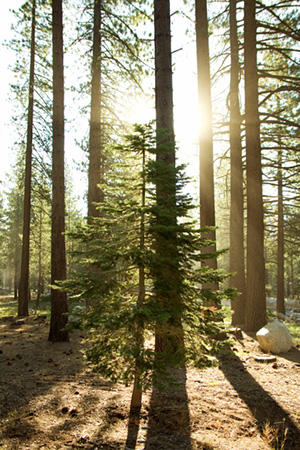Learn
Hardwood or Softwood?
Watch Alabama Hardwoods and Softwoods.
Hardwood or Softwood?
Trees are divided into two classes:
- Hardwoods, which have broad leaves, and
- softwoods, which have needle-like leaves or scale.


Hardness
No degree of hardness divides the hardwoods from the softwoods. Some hardwoods are soft and some softwoods are hard.
The term softwood originated in New England, where the loggers applied it to the light wood of white pine, a conifer (a tree with needle-like or scale-like leaves that bears cones. The longleaf pine is an example of a conifer). The term was applied to all conifers, regardless of their wood density.
Hardwood was the term given to hard maple, a dense wood, and thereafter to all deciduous (a tree that sheds its leaves annually. The water oak is an example of a deciduous tree.) species.
Destinguishing Features
If it isn’t hardness, then what does differentiate between a hardwood and a softwood? Here are two distinct anatomical features that distinguish hardwoods from coniferous species.
- Hardwoods possess vessels, commonly called pores, when viewed in a transverse section.
- If no pores are present, the species is a softwood or conifer.
- Some conifers, such as southern yellow pine, show small, fairly evenly distributed openings called resin ducts on a transverse surface.
- They appear as small light-colored areas in the dark summerwood.
- The pores in hardwoods are closer together than are resin ducts.
Let's look at some of the differences between hardwoods and softwoods
If you wish, you may read the Basic Guide to Identification of Hardwoods and Softwoods for more information.
Pores
Wood can readily be identified as a hardwood or softwood by the presence or absence of pores when viewed in a transverse section (the side-to-side portion of the tree that is visible if you cut through the trunk. This is where you can see the rings of the tree.
If no pores are present, the section is softwood. Pines show small, fairly evenly distributed resin ducts on a transverse surface. Resin ducts should not be confused with the pores in hardwoods. The pores in hardwoods are closer together than are the resin ducts in softwoods.

Compare the images below. Notice that the pores are present in the hardwood sample, but are not present in the softwood sample.


Lamella
When the wood from a conifer is viewed from the top, in transverse section, tracheids (water carriers) from the bulk of the wood surface. Between the various cells is a cementing substance called the middle lamella. Springwood (formed in the spring) cells are distinguished by their larger size from the smaller summerwood cells. Together the springwood and summerwood (formed in the summer) cells make up the annual ring, which is added to the tree each year. Certain chemicals can be used to dissolve the middle lamella, remitting the fibers to be separated. This process is used in making paper.
Medullary Rays
When the wood is viewed in a vertical plane, medullary rays will be seen. Their function is to store food and distribute it horizontally. There are two types of rays:
- Fusiform medullary rays
- Rays with horizontal resin ducts
Sap
Softwoods use fibers to transfer sap. Simple pits are unthickened portions of cells walls through which sap passes from ray cells to fibers, or vice versa. Bordered pits on the surface have their margins overhung by the surrounding cell walls. Hardwoods have specialized pores or vessels for conducting sap. The pores in hardwoods vary in size depending on the species. Some are visible to the naked eye. Hardwood vessels are cells with open ends, one above the other, and continuing as open passages for long distances. In the heartwood and sapwood of some species, the pores are filled with tyloses (An organic material that is extruded into tracheids and pores of trees from adjacent parenchyma cells. Parenchyma cells are thin-walled structures that participate in the metabolism and storage of sugars. The strength giving elements of hardwood are called wood fibers. Usually wood fibers have small cavities and thick walls. Pits are found in the fiber walls, which allow the sap to pass from one cavity to another.
Hardwood Trees
What are some examples of hardwood trees?
- Hickory
- Yellow Poplar
- Southern Red Oak
- Water Oak
- White Oak
- Willow Oak
- Red Maple
Hardwoods
Watch Discovering Alabama: Hardwoods. You will need the information in this video to complete 2.03 Hardwoods.
Softwood Trees
What are some examples of softwood trees?
- Shortleaf Pine
- Longleaf Pine
- Loblolly Pine
- Slash Pine
Softwoods
Watch Discovering Alabama: Softwoods. You will need the information in this video to complete 2.03 Softwoods.